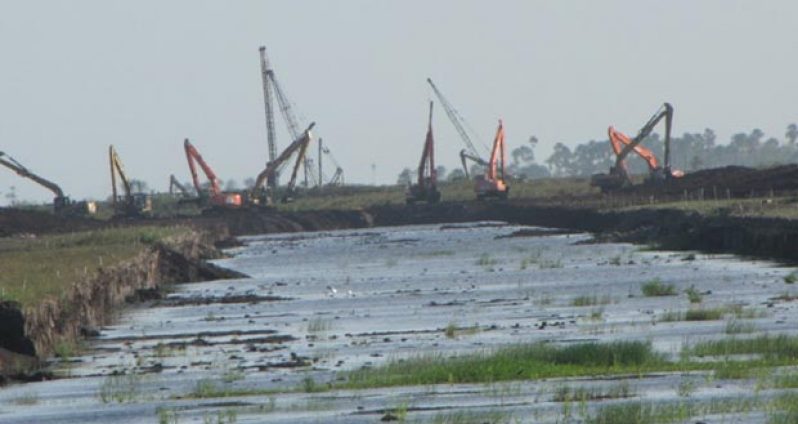THE completion of the Hope Canal will now go into the first quarter of next year due to challenges with the fourth component of the project-the Hope Canal’s outfall sluice, the eight-gate sluice at the canal’s Atlantic end.

Minister of Agriculture, Dr. Leslie Ramsammy, in an interview with the Guyana Chronicle, said the construction firm, Courtney Benn Contracting Services, has agreed to a six-tranche plan to ensure completion.
“A mechanism is in place to ensure that works are completed and by February 2014 the bulk of the work should be done,” he said.
The minister also made it clear that, in view of the fact that it was made clear that works going over the December 31 deadline will not be tolerated the liquidated damages clause will be enforced come January 2014.
“We will deliver, a little later, but we will deliver and within cost,” Ramsammy stressed.
He acknowledged that contractors faced genuine challenges in the construction process.
“We have worked with them and they have worked with us to ensure we have completion. What we saw were genuine difficulties and it is important to note that this was a massive project that was taken on by local contractors and will be completed by local contractors,” Ramsammy explained
According to him, termination of the contract with Courtney Benn Contracting Services would not be feasible, particularly considering that the challenges were genuine and a new tendering process will take longer than the three-month extension.
Ramsammy said: “The work we are seeing is quality work, but difficulties caused the work to lag…it should be noted though that the project will be completed within cost.
“What the public should know is that we took on a difficult project and during the project difficulties came up, but despite this its completion is within sight.”
He noted that work on the other three components will be completed, save for work on the 10-kilometre channel from the East Demerara Water Conservancy (EDWC) and the conservancy head regulator – works that require the outfall sluice to be completed before they can be finished.
He said the work on the channel is about 75 per cent complete, the head regulator about 80 per cent complete and the bridge stands at 96 per cent completion.
“Mr. Dip Singh, of Dip Con, the contractor doing the bridge, is prepared to hand over the bridge to us on December 20 for commissioning,” he said.
Construction on the project began in February 2011 with an estimated 18 months for completion, and the deadline for the project was initially set for June of this year, but was subsequently extended to the end of August, then again extended to December 31 and now to the first quarter of 2014.
FLOODING CONCERNS
Responding to concerns of possible flooding in the Mahaica/Mahaicony/Abary (MMA) area, Ramsammy gave the assurance that efforts are being taken to minimise this possibility.
When the US$15M Hope Canal project was taken on, the expectation was the alleviation of flooding in the MMA areas during rainy periods.
In the past, the Maduni sluice had to be opened to drain the East Demerara Water Conservancy when heavy rains caused it to overtop and residents in the MMA area had to battle a rise in the Mahaica Creek, making completion of the Hope Canal something that is greatly desired.
“The hope is that we don’t have to open neither the Maduni nor Lama sluices,” Ramsammy said.
He pointed out that in the current rainy season Guyana is experiencing, the month of November was listed as the month with the highest level of rainfall so far and due to interventions, the Maduni and Lama sluices did not have to be opened.
On that note, the minister referenced the 2013 budget cuts and bemoaned the fact that the allocation for the Cunha sluice was cut.
“The Hope Canal was designed to work with Cunha….this is why when the budget was cut, so was Cunha, and in doing so we put lives and livelihoods at risk,” Ramsammy said.
The minister explained that the Cunha Canal plays a very significant role as it relates to the effective functioning of the Hope Canal, since the latter is highly dependent on the former, if it is to carry out its expected tasks.
He noted that even after the restoration of the sluice in 2005, he said Cunha was only working at about 40 percent of its original capacity before it was filled in, and as such operations were not optimal.
In light of this reduced capacity, the minister said some areas are highly dependent on the Maduni Sluice and Lama Conservancy, which still leaves several areas vulnerable to flooding.
“The situation at hand now is that even with Hope there is a risk of flooding in the MMA areas,” he said.
Ramsammy stressed that the Hope Canal was designed to reduce dependency on Lama and Maduni, but to do so effectively it will depend on the Cunha sluice.
Considering the importance of Cunha, he stated that support from the Guyana REDD+ Investment Fund (GRIF) will allow works to continue.
The necessary feasibility studies are currently ongoing.
(By Vanessa Narine)



.jpg)









